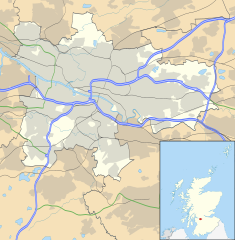| Govan Municipal Buildings | |
|---|---|
 The building in 2018 The building in 2018 | |
| Location | Orkney Street, Govan |
| Coordinates | 55°51′40″N 4°18′31″W / 55.8612°N 4.3086°W / 55.8612; -4.3086 |
| Built | 1866 |
| Architect | John Burnet |
| Architectural style(s) | Greek Revival style |
| Listed Building – Category B | |
| Official name | Govan Municipal Buildings, 18–20 Orkney Street, Glasgow |
| Designated | 15 May 1987 |
| Reference no. | LB33361 |
 | |
Govan Municipal Buildings is a former local authority building on Orkney Street in Govan, Scotland. The building, which was the meeting place of the local burgh council in the 19th century, is a Category B listed building.
History
Following significant population growth, largely associated with the shipbuilding industry, the area became a police burgh in 1864. The new police commissioners initially met in Hinshelwood's hall in Greenhaugh Street but, after finding this arrangement inadequate, decided to commission dedicated municipal buildings for the burgh. The site they chose, on the west side of Albert Street (since renamed Orkney Street), was occupied by a goods shed for the Glasgow and Paisley Joint Railway.
The foundation stone, incorporating a time capsule, for the new building was laid in 1866. It was designed by John Burnet in the Greek Revival style, built in ashlar stone and was completed in 1867. The design involved a broadly symmetrical main frontage facing onto Albert Street. The central bay contained a round headed doorway with an architrave. The other four bays on the ground floor were fenestrated with sash windows. On the first floor, there was a Corinthian order pilastrade involving seven recessed sash windows and, at roof level, there was a modillioned cornice and a central roof lantern. Internally, the principal room was an assembly hall on the first floor which could accommodate 600 people.
A major fire caused considerable damage in 1882. The building was subsequently restored and extended in the same style by four extra bays to the south, to create extra accommodation for the fire service and police force, in 1899. A new cell block stretching back at the rear was added at around the same time. The building ceased to be the local seat of government when the burgh council relocated to the new Govan Town Hall in Govan Road in 1901.
It is claimed that the German Deputy Führer, Rudolf Hess, was briefly held in the building after his flight to Scotland in May 1941 during the Second World War. This seems likely as Orkney Street is on the route between Waterfoot, where he was captured, and Maryhill Barracks where he was interrogated. However, other sources claim that he was held at Giffnock Police Station. After being charged with breach of the peace, the footballer, Frank McAvennie, was held in the building in November 1987: he was found not guilty at the subsequent trial.
The building continued to serve as a police station, until the police service moved to the new Helen Street police station in 1998. Following a major refurbishment at a cost of £3.6 million in 2008, the building has operated as the Orkney Street Enterprise Centre; the cell block at the rear was converted for use as serviced office space for small businesses.
See also
References
- Historic Environment Scotland. "Govan Municipal Buildings, 18–20 Orkney Street, Glasgow (Category B Listed Building) (LB33361)". Retrieved 28 August 2024.
- "Govan". The Glasgow Storey. Retrieved 28 August 2024.
- "Ordnance Survey Six-inch 1st edition, 1843–1882". Retrieved 26 August 2024.
- ^ "Burgh of Govan". Govan Reminiscence Group. Retrieved 28 August 2024.
- Historic Environment Scotland. "Glasgow, 18–20 Orkney Street, Govan Municipal Buildings (260272)". Canmore. Retrieved 28 August 2024.
- "Govan Town Hall". The Glasgow Story. Retrieved 28 August 2024.
- ^ "Orkney Street Police Station gets make over". Evening Times. 19 September 2008. Retrieved 28 August 2024.
- "Maclean taking 'hard-cell' approach to newspaper business". All Media Scotland. 8 September 2009. Retrieved 28 August 2024.
- "How Nazi leader Rudolf Hess ended up in a cell south of Glasgow". Glasgow Times. 6 June 2022. Retrieved 28 August 2024.
- "The Glasgow Crime Story of Nazi leader Rudolf Hess who crash-landed in the city". Glasgow Times. 24 April 2022. Retrieved 28 August 2024.
- "Group photograph of Govan Police Force, probably late 19th century". The Glasgow Story. Retrieved 16 April 2020.
- "Govan nick, temporary home to Mr R. C. Nesbit and Herr R. Hess, is closing for business". The Herald. 31 January 1998. Retrieved 28 August 2024.
- "Orkney Street Enterprise Centre". Get into Govan. Retrieved 28 August 2024.
External links
 Media related to Former Govan Police Building at Wikimedia Commons
Media related to Former Govan Police Building at Wikimedia Commons